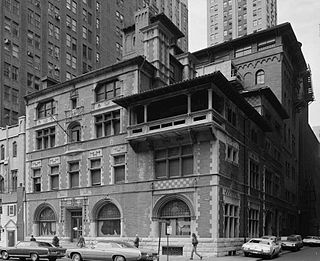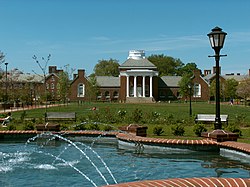
The University of Delaware is a private-public land-grant research university located in Newark, Delaware. UD is the largest university in Delaware. It offers three associate's programs, 148 bachelor's programs, 121 master's programs, and 55 doctoral programs across its eight colleges. The main campus is in Newark, with satellite campuses in Dover, the Wilmington area, Lewes, and Georgetown. It is considered a large institution with approximately 18,200 undergraduate and 4,200 graduate students. It is a privately governed university which receives public funding for being a land-grant, sea-grant, and space-grant state-supported research institution.
Charles Zeller Klauder was an American architect best known for his work on university buildings and campus designs, especially his Cathedral of Learning at the University of Pittsburgh, the first educational skyscraper.

Wesleyan College is a private, liberal arts women's college in Macon, Georgia. Founded in 1836, Wesleyan was the first college in the world chartered to grant degrees to women.

Collegiate Gothic is an architectural style subgenre of Gothic Revival architecture, popular in the late-19th and early-20th centuries for college and high school buildings in the United States and Canada, and to a certain extent Europe. A form of historicist architecture, it took its inspiration from English Tudor and Gothic buildings. It has returned in the 21st century in the form of prominent new buildings at schools and universities including Princeton and Yale.

Marycrest College Historic District is located on a bluff overlooking the West End of Davenport, Iowa, United States. The district encompasses the campus of Marycrest College, which was a small, private collegiate institution. The school became Teikyo Marycrest University and finally Marycrest International University after affiliating with a private educational consortium during the 1990s. The school closed in 2002 because of financial shortcomings. The campus has been listed on the Davenport Register of Historic Properties and on the National Register of Historic Places since 2004. At the time of its nomination, the historic district consisted of 13 resources, including six contributing buildings and five non-contributing buildings. Two of the buildings were already individually listed on the National Register.

Amos Jerome Snell Hall and Charles Hitchcock Hall, more commonly known as Snell–Hitchcock, make up a residence hall at the University of Chicago. The dorm is on the northwest corner of the University's main quadrangles at the corner of 57th St. and Ellis Avenue. It is connected via emergency exits to Searle Chemistry Laboratory. Built in 1892 (Snell) and 1901 (Hitchcock), they are the oldest residence halls still in use as such on the university's campus. Snell is built in a Collegiate Gothic style, while Hitchcock is Prairie Style-inspired Gothic. The buildings feature fireplaces and exteriors of limestone, as well as hardwood molding and trim.

The Webb Horton House, is an ornate 40-room mansion in Middletown, New York, United States, designed by local architect Frank Lindsey. Built 1902-1906 as a private residence, since the late 1940s it has been part of the campus of SUNY Orange. This building is now known as Morrison Hall, after the last private owner, and houses the college's main administrative offices. A nearby service complex has also been kept and is used for classrooms and other college functions.

Heritage Hall is the oldest building on the campus of Valparaiso University in the U.S. state of Indiana. Built in 1875 by John Flint, it was used as a residence hall for men. In 1878, a fire destroyed the third floor. The building was later purchased by Richard Abraham Heritage, remodeled into a two-story school of music, and renamed Heritage Hall. At different times throughout its history, Heritage Hall underwent renovations. It was used as a dormitory, a barracks, a machinery classroom, and finally a library when Valparaiso University was bought by the Lutheran University Association in 1925. In 1959, the new Moellering Library had been completed and the building was converted to classrooms and offices. Heritage Hall was placed on the National Register of Historic Places in 1976.

The Main Campus is the primary campus of North Carolina State University, located in Raleigh, North Carolina, US, inside the Beltline. Notable features of Main Campus include the Bell Tower and D. H. Hill Library. The campus is known for its distinctive red brick buildings, sidewalks, plazas, and sculptures; some are dotted with decorative brick mosaics. University Plaza is nicknamed "The Brickyard" because it is mostly a flat, open, bricked area.

Frank Miles Day was a Philadelphia-based architect who specialized in residences and academic buildings.

The Drake University Campus Historic District is located in Des Moines, Iowa, United States. The historic district contains six buildings. Five of the buildings are collegiate buildings on the Drake University campus and one is a church. The period of significance is from when the university was founded in 1881 to the end of the presidency of Hill M. Bell in 1918. The historic district has been listed on the National Register of Historic Places since 1988. It is part of the Drake University and Related Properties in Des Moines, Iowa, 1881—1918 MPS.

The Main Library is a historic library on the campus of the University of Illinois at Urbana–Champaign in Urbana, Illinois. Built in 1924, the library was the third built for the school; it replaced Altgeld Hall, which had become too small for the university's collections. Architect Charles A. Platt designed the Georgian Revival building, one of several on the campus which he designed in the style. The building houses several area libraries, as well as the University Archives and The Rare Book & Manuscript Library. The Main Library is the symbolic face of the University Library, which has the second largest university library collection in the United States.

The Bronx Community College Library is located on the campus of Bronx Community College and is a part of the City University of New York system.

Bond Hall is a building on the campus of the University of Notre Dame which hosts student learning initiatives and a number of institutes including the Graduate School. It was originally built in 1917 as the Lemmonier Library and it housed the Notre Dame School of Architecture from 1964 to 2019. The architect was Edward Lippincott Tilton, a neoclassical architect who specialized in libraries. Its front steps are famous as the location of the Notre Dame Marching Band performances before the football games.

The University of Michigan Central Campus Historic District is a historic district consisting of a group of major buildings on the campus of the University of Michigan in Ann Arbor, Michigan. It was listed on the National Register of Historic Places in 1978.
Northern Vermont University (NVU) is a public university with campuses located in the towns of Johnson and Lyndon in the U.S. state of Vermont. Established in 2018 by the unification of the former Johnson State College and Lyndon State College, the university offers over 50 Bachelor's degree programs and Master's degree programs.

The Delaware Public Library is a former public library in Delaware, Ohio. The building was funded by Andrew Carnegie and built in the neoclassical style. It opened to the public in 1906. The library's collection of books and volumes rapidly expanded during its operational history. By the 1970s, the Delaware Public Library started to run out of space. In 1984, a new public library was constructed, and Delaware County, Ohio started using the Delaware Public Library for office space. The building was tripled in size during a construction and restoration project that lasted from 1999 to 2001. The Delaware Public Library is currently used to house a number of Delaware County agencies, including the Delaware County Board of Commissioners.

The Lafayette College campus is a 110-acre suburban area located on College Hill in Easton, Pennsylvania. Lafayette College also owns and maintains a 230-acre athletic complex, the Metzgar Fields Athletic Complex, and leases a 1,500 square foot space in New York City. The school is roughly 70 mi (110 km) west of New York City and 60 mi (97 km) north of Philadelphia.






















